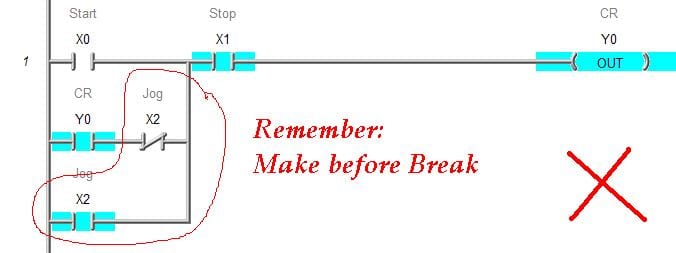We will look at how to troubleshoot a plc racing condition.
Two examples are explained in racing conditions in the PLC. The PLC will update only at the end of the program logic. Items set will not happen until the I/O is refreshed. How to trigger events when you want them is discussed.
Your control system does not work. Where do you start? Let’s walk through a series of questions to determine where the problem lies.
Troubleshooting a PLC – Starting
Is this a new installation or a previous installation that was running fine? Determine if the system has been running well in the past and has currently stopped working correctly. This is the indication that the problem relies upon the system.
Is there anything that has happened outside of the system? Has there been a lightening strike, blown drives on other systems, etc.? This can point to the original cause of the malfunction.
Gather Information for Troubleshooting
What is the system doing now, and what should it be doing? Gather all of the information you can from every resource you can.
- Supervisors – machine, location, time of the error, other happenings in the plant, etc
- Operators – What is it currently doing? What should it be doing? What do you think is wrong?
Operators of the equipment are your key resource in finding, correcting and ensuring the error does not happen again. They know the equipment from an operational point of view which can assist you greatly in troubleshooting.
PLC fatal and non-fatal errors:
Troubleshoot a PLC
If the machine is still running partially, then this is an indication of a non-fatal error. Cannot run at all is usually a fatal error.
Take a look at the PLC indicator lights on the CPU. Refer to the operation manual for the PLC for troubleshooting specific lights on the CPU. The following are general tips:
If no lights are on, the possible cause is a power supply. This is usually the most common of errors on a PLC system. Meantime before failure (MTBF) is rated on the lowest rating of components which is typically the power supply.
If the run light is on and an error light is flashing, this usually indicates internal errors such as batteries, scan time, etc. It is usually not the reason for the lack of operation.
If the run light is on and no other errors are seen on the CPU, we can put the PLC program at the bottom of the list of items that could be the cause.
Check the input cards of the PLC. You should see the individual sensors lighting up the inputs. If not, check the power supply to the input card/cards.
Ask the operator what is happening and what is supposed to happen. Try to follow the sequence of events in the PLC to determine whether an input or output device is not working.
Some items to watch:
- Noise on analog input signals (Variable)
- DC Solenoids (High input voltage spikes without surge suppressors)
- The leakage current on two-wire sensors (False triggering the input)
New PLC installation troubleshooting
If this is a new PLC program that you are doing, start with a logic flow diagram. This will determine the procedure to start programming.
Every program can be done in several ways. The best method is the most documented one.
Documentation is the mark of a good program.
Some trouble with new programs can be racing conditions. This is usually a case of not understanding how the PLC scans logic. The PLC will generally scan from left to right, top to bottom. The output bits/words are available to the inputs of the next rung of logic. (Modicon PLCs will scan differently.) Actual outputs and information are not read until the end of the scan of the PLC. Racing conditions happen when the outcome is set on multiple rungs but will not get set until the end of the scan. Think of it as the last action that will always win, so if this happens, move the logic to the end of the program and see if it works. Then go back and see where the output was also set. (Refer to your programming software on how to get cross-references.) Cross-reference guides are ideal for this purpose.
We have discussed just a few troubleshooting techniques. Hopefully, now you know how to start looking for the errors in your system. Let me know how you make out.
Watch on YouTube: How to Troubleshoot a PLC
Do you know of additional tips or methods to share?
If you have any questions or need further information, please contact me.
Thank you,
Garry
If you’re like most of my readers, you’re committed to learning about technology. Numbering systems used in PLCs are not challenging to learn and understand. We will walk through the numbering systems used in PLCs. This includes Bits, Decimal, Hexadecimal, ASCII, and Floating Point.
To get this free article, subscribe to my free email newsletter.
Use the information to inform other people how numbering systems work. Sign up now.
The ‘Robust Data Logging for Free’ eBook is also available for free download. The link is included when you subscribe to ACC Automation.







